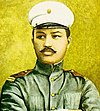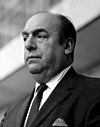Welcome! Check out today's deaths, recent deaths, or our deaths stats.
Feeling experimental? Head on over to our newest (and darkest) feature: Next-2-Die™ predictions
 Juan Luna
Juan Luna


Filipino painter, sculptor and political activist (1857-1899).
Born October 25th, 1857 in Badoc. [ref]
Died December 7th, 1899 at 42 years old in Hong Kong (disease).
Juan Luna, a Filipino painter, sculptor, and political activist, died on December 7, 1899 at the age of 42. A leading light of the Philippines' artistic scene, he won numerous awards for his works, many of which remain iconic within the country and abroad. Born in 1857, Luna was a student at San Juan de Letran College when he and fellow artist Felix Resurrección Hidalgo submitted two paintings to the Exposición Nacional de Bellas Artes in 1877, for which they were awarded gold medals. This success launched Luna’s career, and he went on to join the art movement known as the Propaganda movement, which sought to gain Philippine independence from Spain. His subsequent works combined politics and creativity, with his best-known creations being the Spoliarium (1884), The Parisian Life (1892), and The Battle of Lepanto (1887), the latter of which was commissioned by King Alfonso XII of Spain. Luna's works are widely regarded as masterpieces that remain relevant today, and are regularly displayed in art galleries the world over. His presence in the Philippines art scene is immortalized through the premises of the Juan Luna Scholarship Fund and the Juan Luna Avenue in the country’s Tondo district. Luna’s legacy is an inspiration to the artists, historians and activists of today, demonstrating that art can be used to bring about political change. His is an incredible legacy that will be remembered for generations to come.
You might also be interested in...




Death never takes the wise man by surprise, he is always ready to go. Jean de La Fontaine